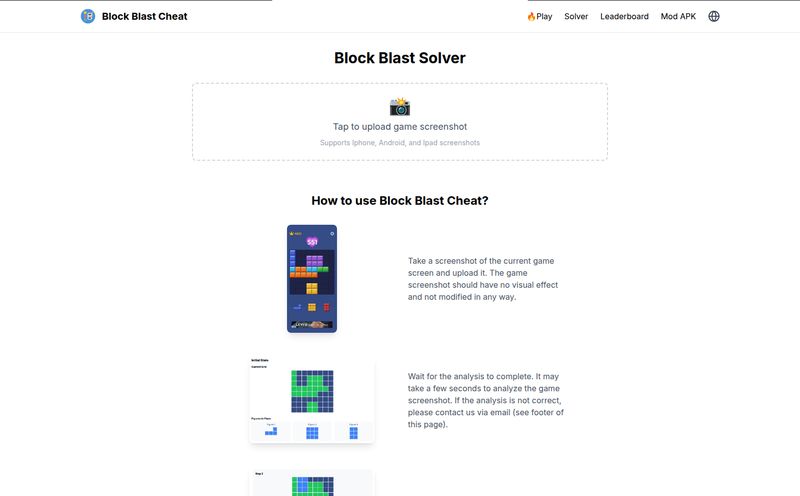If you're a developer, you probably enjoy writing elegant, efficient code. You probably do not enjoy trying to translate that beautiful code into bullet points on a black-and-white document. Updating a resume is a universal chore, a bit like doing taxes or cleaning out the fridge. You know you have to do it, but you'll put it off until the last possible second.
For years, we've been stuck in this cycle: build something cool, forget the details a month later, then scramble to remember what specific libraries you used when a dream job posting appears. It’s a frustrating game of reverse-engineering your own accomplishments. So when I heard about a tool called GitFolio, which claims to use AI to automatically build and update your resume based on your GitHub activity, my ears perked up. My inner SEO-and-tech-nerd was both skeptical and incredibly intrigued. Is this just another resume template site with some AI buzzwords sprinkled on top, or is it a genuine game-changer? I had to find out.
So, What Exactly is GitFolio?
First off, let's clear up what this isn't. It's not just another Canva or Zety clone where you plug your details into a pretty template. GitFolio's entire premise is built around a developer's single source of truth: their GitHub profile. It acts like a clever personal assistant that peeks into your public repositories, analyzes your commits, understands the languages and frameworks you're using and then crafts professional, experience-based bullet points from that activity.
The whole idea is to create a living resume. One that evolves as you code. You push a new feature to your side project? Your resume gets a potential new line item. You contribute to a major open-source project? That experience is logged and ready to be showcased. It’s like git merging your career history, continuously. A pretty cool concept, especially since the platform is proudly in its BETA phase, which to me always signals a chance to get in early on something interesting.

Visit GitFolio
First Clicks and Initial Thoughts
Hopping onto the site, I was greeted with a clean, minimalist interface. No fluff. I appreciate that. It immediately put me in a "Limited Access Mode," offering 5 free chat credits to get started. This freemium-style approach is smart; it lets you test the waters without even creating an account. The promise of getting 45 more credits just for signing up is a pretty good carrot on a stick.
The process feels less like filling out a form and more like starting a conversation. Which brings me to one of its core components.
The Killer Feature: That GitHub Sync
This is GitFolio's secret sauce. The moment you connect your GitHub account, the magic is supposed to happen. The AI scans your activity and starts populating your resume. I've spent more hours than I'd like to admit trying to quantify my work on past projects. Was it a 'performance optimization' or did I 'refactor the state management logic to reduce re-renders by 30%'? GitFolio aims to bridge that gap. It sees you used React, TypeScript, and Styled-Components in a project and helps you articulate that in a way that hiring managers and—more importantly—recruiting software can understand.
This single feature solves one of the biggest points of friction for developers. It's not about being lazy; it's about being efficient. We use tools to automate deployments and testing, so why not automate the tedious parts of self-promotion too?
A Deeper Look at the Features
Beyond the main hook, there are a few other things that caught my eye.
AI-Powered Resume Chat
This is where those "chat credits" come in. You have an AI assistant you can talk to. You can ask it to "rephrase this section to sound more senior" or "highlight my experience with REST APIs." It’s an interactive editing process. Now, I have to be honest, the suggestions aren't always poetry. Sometimes they're a bit generic. Think of it less as a ghostwriter and more like a super-powered thesaurus and writing partner. It's like using GitHub Copilot—it gives you a fantastic starting point, but you're still the pilot who has to land the plane.
Beating the Resume Robots (ATS-Friendly)
Ah, Applicant Tracking Systems. The digital gatekeepers that decide if a human ever even sees your application. According to a report from Jobscan, a staggering 75% of resumes are rejected by an ATS before a recruiter sees them. Why? Usually because of formatting issues, weird fonts, or an inability for the bot to parse columns and graphics. GitFolio states its output is ATS-friendly. This is huge. A beautiful, creative resume is useless if the first 'person' to see it is a robot that can't read it. GitFolio focuses on a clean, parsable structure, which might just be the most valuable feature of all.
Job Description Matching and LinkedIn Imports
Two other nice touches are the ability to import your data from LinkedIn and a feature to match your resume to a specific job description. The job description matching is particularly potent. You can paste in the text from a job ad, and the AI can help you tweak your resume to better reflect the required skills and keywords. It’s a targeted approach that every job-hunting expert recommends, but it's usually a manual and time-consuming process. Automating this? Yes, please.
The Good, The Bad, and The Beta Bugs
No tool is perfect, especially one in beta. After playing around with it, here's my honest breakdown.
What I Genuinely Liked
The time-saving aspect is undeniable. The automation of pulling from GitHub is brilliant. It takes the initial 'blank page' paralysis completely out of the equation. For a junior dev or a recent bootcamp grad who has been pushing a lot of code to GitHub to build their portfolio, this tool is an absolute godsend. It helps you see the value in the work you've already done. I also loved teh easy-to-use interface. It's clean, intuitive and just works.
Where It Could Improve
The heavy reliance on GitHub is both a strength and a weakness. What if you're a senior developer whose best work is locked away in a corporate, private GitLab or Bitbucket instance? GitFolio can't see that. In that case, it becomes more of a manual resume builder. Also, the limited free credits mean you have to be strategic with your AI chats. You can't just endlessly experiment without eventually signing up or, presumably, paying.
The Great Pricing Mystery
Naturally, I went looking for the pricing page to see what this would cost long-term. And... I was greeted with a beautiful, stark "404 Page Not Found" error. Honestly, I chuckled. It's such a classic beta-phase issue. While it means I can't give you a hard number, the credit system suggests a future freemium or pay-as-you-go model. Perhaps a monthly subscription for unlimited use, or buying packs of credits. For now, it's free to try, and that's what matters.
Who Should Be Using GitFolio?
So, who is this for? I'd say it's perfect for a few key groups:
- Students and Bootcamp Grads: Anyone who is actively building their portfolio on GitHub will see immediate value.
- Active Open Source Contributors: It's a fantastic way to automatically document and articulate your contributions.
- Any Developer Who Hates Writing Resumes: So... basically all of us? It gets you 80% of the way there with minimal effort.
It might be less useful for very senior engineers whose most significant work isn't on public GitHub or for folks in tech-adjacent roles. But for the core audience of active coders, it hits the mark.
Frequently Asked Questions About GitFolio
Is GitFolio free to use?
Yes, you can get started for free. It operates on a credit system for its AI chat feature. You get a few free credits to start and can earn more by creating an account. Future paid plans seem likely, but the basic functionality is accessible.
Can I customize the resume templates?
Customization is a core part of the process, primarily through the AI chat. You can instruct the AI to change wording, focus on different skills, and adjust the content. The visual template itself appears to be standardized for ATS compatibility.
Is a GitFolio resume better than one I make myself?
It's different. It's almost certainly faster and more likely to be ATS-friendly. However, the best resume will likely come from using GitFolio to generate a strong, data-driven draft and then adding your own final human touch to perfect the narrative and details.
Does it work with GitLab or Bitbucket?
Currently, the main automated feature is built specifically around the GitHub API. So, if your code lives elsewhere, you won't be able to use the automatic update feature, but you could still use the manual builder and AI chat.
What happens when I run out of chat credits?
You'll need to create an account to get a larger batch of credits. In the future, it's expected that there will be an option to purchase more credits or subscribe to a plan for unlimited access.
Final Thoughts: Is It The Future?
So, is GitFolio the end of writing resumes for developers? Not entirely. But it might be the end of hating it. It transforms the process from a tedious writing exercise into an interactive, data-driven task. It's a smart tool that understands its audience perfectly.
Despite the beta quirks and the mysterious 404 on the pricing page, I'm optimistic. Tools like this represent a shift in how we manage our professional identities. They help us focus on what's important—building great things—while handling the administrative hassle of showing it off. For me, anything that reduces the friction between doing the work and proving the work is a massive win. GitFolio is definitely a project to watch, and I'd recommend any developer to connect their GitHub and see what it spits out. You might be surprised at how good you look on paper.



